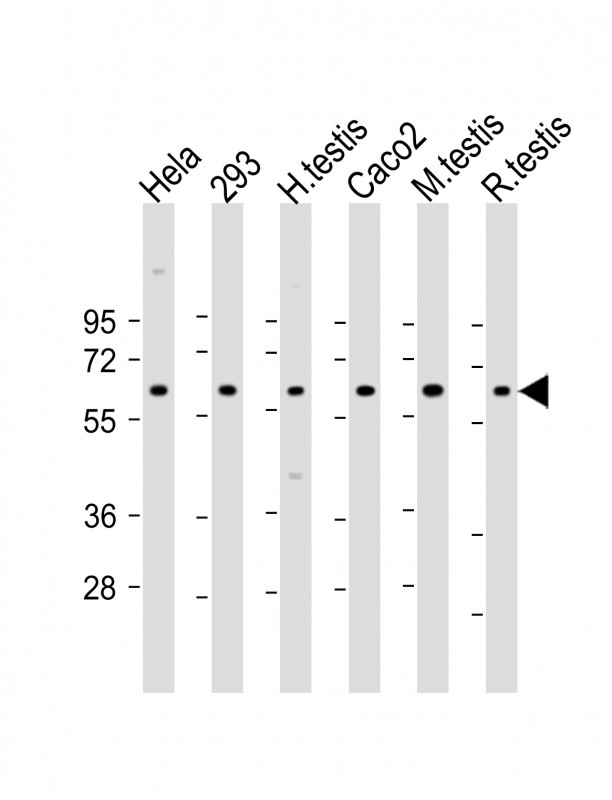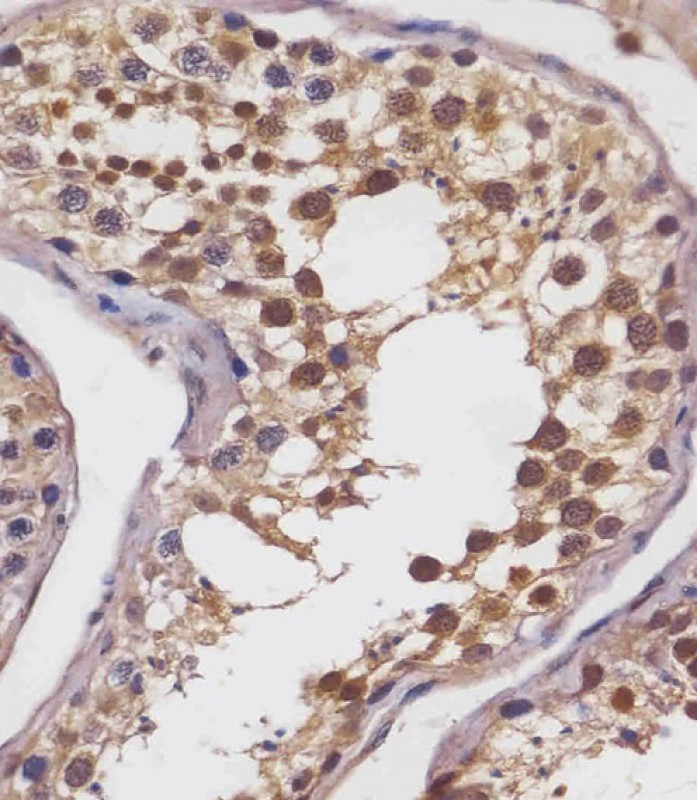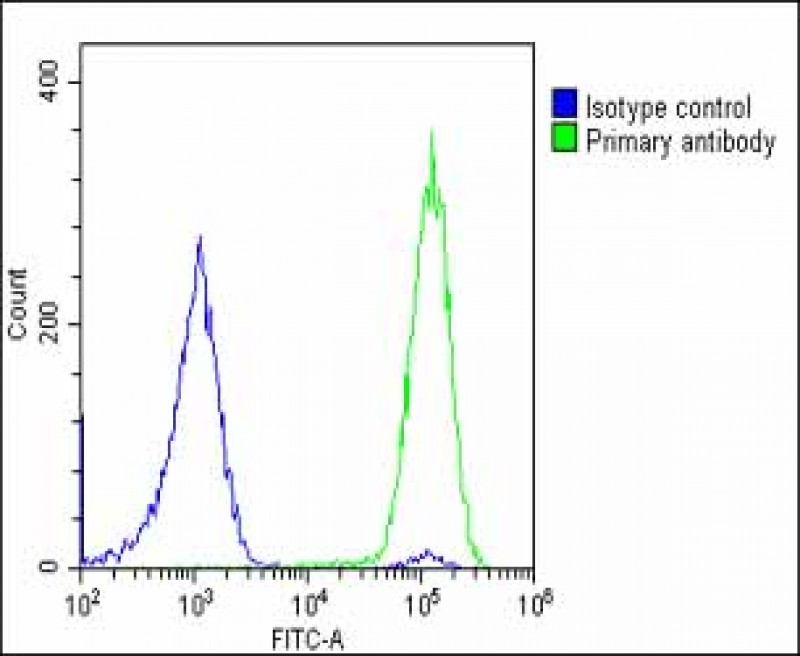SLC2A8 Antibody (Center)
Purified Rabbit Polyclonal Antibody (Pab)
- SPECIFICATION
- CITATIONS
- PROTOCOLS
- BACKGROUND

Application
| WB, IHC-P, FC, E |
|---|---|
| Primary Accession | Q9NY64 |
| Other Accession | P58354 |
| Reactivity | Human, Mouse, Rat |
| Predicted | Bovine |
| Host | Rabbit |
| Clonality | polyclonal |
| Isotype | Rabbit IgG |
| Calculated MW | 50819 Da |
| Gene ID | 29988 |
|---|---|
| Other Names | Solute carrier family 2, facilitated glucose transporter member 8, Glucose transporter type 8, GLUT-8, Glucose transporter type X1, SLC2A8, GLUT8, GLUTX1 |
| Target/Specificity | This SLC2A8 antibody is generated from a rabbit immunized with a KLH conjugated synthetic peptide between 260-292 amino acids from the Central region of human SLC2A8. |
| Dilution | WB~~1:2000 IHC-P~~1:25 FC~~1:25 E~~Use at an assay dependent concentration. |
| Format | Purified polyclonal antibody supplied in PBS with 0.09% (W/V) sodium azide. This antibody is purified through a protein A column, followed by peptide affinity purification. |
| Storage | Maintain refrigerated at 2-8°C for up to 2 weeks. For long term storage store at -20°C in small aliquots to prevent freeze-thaw cycles. |
| Precautions | SLC2A8 Antibody (Center) is for research use only and not for use in diagnostic or therapeutic procedures. |
| Name | SLC2A8 (HGNC:13812) |
|---|---|
| Function | Insulin-regulated facilitative hexose transporter that mediates the transport of glucose and fructose (By similarity). Facilitates hepatic influx of dietary trehalose, which in turn inhibits glucose and fructose influx triggering a starvation signal and hepatic autophagy through activation of AMPK and ULK1 (PubMed:27922102). Also able to mediate the transport of dehydroascorbate. |
| Cellular Location | Cell membrane {ECO:0000250|UniProtKB:Q9JJZ1}; Multi-pass membrane protein. Cytoplasmic vesicle membrane {ECO:0000250|UniProtKB:Q9JJZ1}; Multi-pass membrane protein. Note=Principally intracellular. May move between intracellular vesicles and the plasma membrane. The dileucine internalization motif is critical for intracellular sequestration {ECO:0000250|UniProtKB:Q9JJZ1} |
| Tissue Location | Highly expressed in testis, but not in testicular carcinoma. Lower amounts present in most other tissues |

Thousands of laboratories across the world have published research that depended on the performance of antibodies from Abcepta to advance their research. Check out links to articles that cite our products in major peer-reviewed journals, organized by research category.
info@abcepta.com, and receive a free "I Love Antibodies" mug.
Provided below are standard protocols that you may find useful for product applications.
Background
Insulin-regulated facilitative glucose transporter. Binds cytochalasin B in a glucose-inhibitable manner. Seems to be a dual-specific sugar transporter as it is inhibitable by fructose (By similarity).
References
Doege H.,et al.J. Biol. Chem. 275:16275-16280(2000).
Ibberson M.R.,et al.J. Biol. Chem. 275:4607-4612(2000).
Humphray S.J.,et al.Nature 429:369-374(2004).
Mural R.J.,et al.Submitted (JUL-2005) to the EMBL/GenBank/DDBJ databases.
Burkard T.R.,et al.BMC Syst. Biol. 5:17-17(2011).
If you have used an Abcepta product and would like to share how it has performed, please click on the "Submit Review" button and provide the requested information. Our staff will examine and post your review and contact you if needed.
If you have any additional inquiries please email technical services at tech@abcepta.com.













 Foundational characteristics of cancer include proliferation, angiogenesis, migration, evasion of apoptosis, and cellular immortality. Find key markers for these cellular processes and antibodies to detect them.
Foundational characteristics of cancer include proliferation, angiogenesis, migration, evasion of apoptosis, and cellular immortality. Find key markers for these cellular processes and antibodies to detect them. The SUMOplot™ Analysis Program predicts and scores sumoylation sites in your protein. SUMOylation is a post-translational modification involved in various cellular processes, such as nuclear-cytosolic transport, transcriptional regulation, apoptosis, protein stability, response to stress, and progression through the cell cycle.
The SUMOplot™ Analysis Program predicts and scores sumoylation sites in your protein. SUMOylation is a post-translational modification involved in various cellular processes, such as nuclear-cytosolic transport, transcriptional regulation, apoptosis, protein stability, response to stress, and progression through the cell cycle. The Autophagy Receptor Motif Plotter predicts and scores autophagy receptor binding sites in your protein. Identifying proteins connected to this pathway is critical to understanding the role of autophagy in physiological as well as pathological processes such as development, differentiation, neurodegenerative diseases, stress, infection, and cancer.
The Autophagy Receptor Motif Plotter predicts and scores autophagy receptor binding sites in your protein. Identifying proteins connected to this pathway is critical to understanding the role of autophagy in physiological as well as pathological processes such as development, differentiation, neurodegenerative diseases, stress, infection, and cancer.




